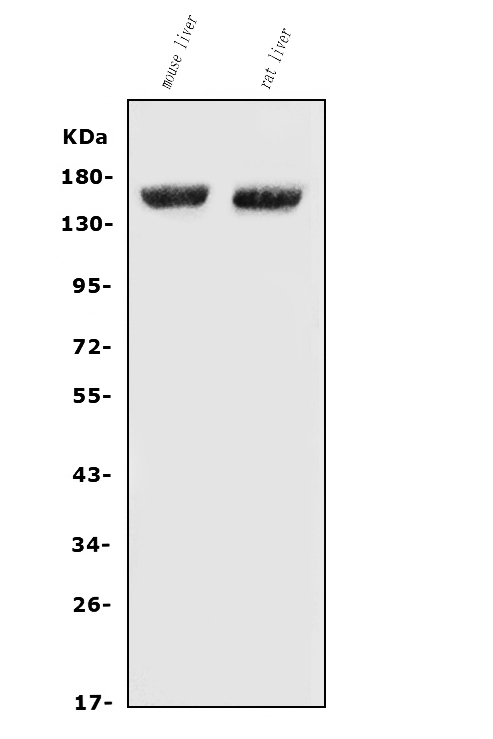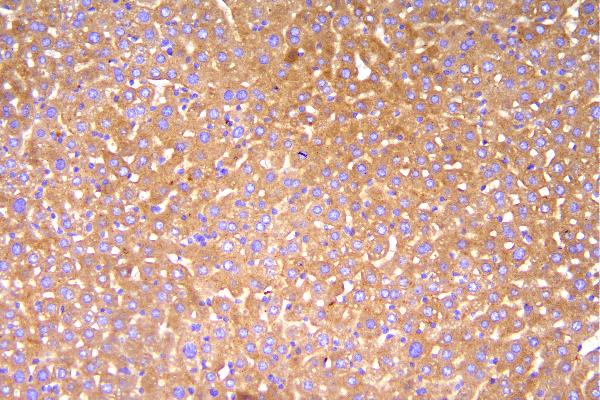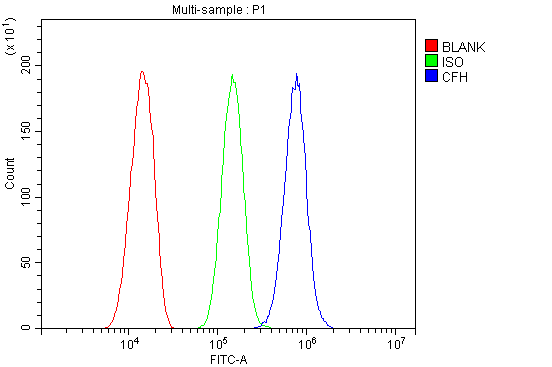| Western blot (WB): | 1:500-2000 |
| Immunohistochemistry (IHC): | 1:50-400 |
| Flow Cytometry (Fixed): | 1:50-200 |

Western blot analysis of anti-Factor H/Cfh antibody (A00562-2).The sample well of each lane was loaded with 30ug of sample under reducing conditions.
Lane 1: mouse liver tissue lysates,
Lane 2: rat liver tissue lysates.
AUse rabbit anti-Factor H/Cfh 1:1000, probed with a goat anti-rabbit IgG-HRP secondary antibody. The signal is developed using an Enhanced Chemiluminescent detection (ECL) kit (Catalog # EK1002). A specific band was detected for Factor H/Cfh at approximately 150KD. The expected band size for Factor H/Cfh is at 139KD.

IHC analysis of Factor H/CFH using anti-Factor H/CFH antibody (A00562-2).
Factor H/CFH was detected in a paraffin-embedded section of mouse liver tissue. Biotinylated goat anti-rabbit IgG was used as secondary antibody. The tissue section was incubated with rabbit anti-Factor H/CFH Antibody (A00562-2) at a dilution of 1:200 and developed using Strepavidin-Biotin-Complex (SABC) (Catalog # SA1022) with DAB (Catalog # AR1027) as the chromogen.

Flow Cytometry analysis of Hepa1-6 cells using anti-Factor H/CFH antibody (A00562-2).
Overlay histogram showing Hepa1-6 cells stained with A00562-2 (Blue line). To facilitate intracellular staining, cells were fixed with 4% paraformaldehyde and permeabilized with permeabilization buffer. The cells were blocked with 10% normal goat serum. And then incubated with rabbit anti-Factor H/CFH Antibody (A00562-2) at 1:100 dilution for 30 min at 20°C. DyLight®488 conjugated goat anti-rabbit IgG (BA1127) was used as secondary antibody at 1:100 dilution for 30 minutes at 20°C. Isotype control antibody (Green line) was rabbit IgG at 1:100 dilution used under the same conditions. Unlabelled sample without incubation with primary antibody and secondary antibody (Red line) was used as a blank control.

Western blot analysis of anti-Factor H/Cfh antibody (A00562-2).The sample well of each lane was loaded with 30ug of sample under reducing conditions.
Lane 1: mouse liver tissue lysates,
Lane 2: rat liver tissue lysates.
AUse rabbit anti-Factor H/Cfh 1:1000, probed with a goat anti-rabbit IgG-HRP secondary antibody. The signal is developed using an Enhanced Chemiluminescent detection (ECL) kit (Catalog # EK1002). A specific band was detected for Factor H/Cfh at approximately 150KD. The expected band size for Factor H/Cfh is at 139KD.

IHC analysis of Factor H/CFH using anti-Factor H/CFH antibody (A00562-2).
Factor H/CFH was detected in a paraffin-embedded section of mouse liver tissue. Biotinylated goat anti-rabbit IgG was used as secondary antibody. The tissue section was incubated with rabbit anti-Factor H/CFH Antibody (A00562-2) at a dilution of 1:200 and developed using Strepavidin-Biotin-Complex (SABC) (Catalog # SA1022) with DAB (Catalog # AR1027) as the chromogen.

Flow Cytometry analysis of Hepa1-6 cells using anti-Factor H/CFH antibody (A00562-2).
Overlay histogram showing Hepa1-6 cells stained with A00562-2 (Blue line). To facilitate intracellular staining, cells were fixed with 4% paraformaldehyde and permeabilized with permeabilization buffer. The cells were blocked with 10% normal goat serum. And then incubated with rabbit anti-Factor H/CFH Antibody (A00562-2) at 1:100 dilution for 30 min at 20°C. DyLight®488 conjugated goat anti-rabbit IgG (BA1127) was used as secondary antibody at 1:100 dilution for 30 minutes at 20°C. Isotype control antibody (Green line) was rabbit IgG at 1:100 dilution used under the same conditions. Unlabelled sample without incubation with primary antibody and secondary antibody (Red line) was used as a blank control.


